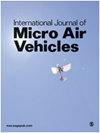Numerical study on aerodynamic characteristics of two-dimensional propulsive wing in cruise and hover
IF 1.6
4区 工程技术
Q2 ENGINEERING, AEROSPACE
引用次数: 3
Abstract
The propulsive wing vehicle is a new concept vehicle, which is driven by a cross-flow fan (CFF) embedded in the trailing edge of the wing. The propulsive wing vehicle is capable of cruising and hovering at high angles of attack with very high aerodynamic force coefficients, and has the potential to become a new type of vertical take-off and landing (VTOL) vehicle. The cruise and hover states of the propulsive wing vehicle are defined, and a numerical model of the two-dimensional propulsive wing is established. Based on the computational fluid dynamics (CFD) method, the rotation of the CFF is simulated by using the sliding mesh technique. The effects of cruise speed, angle of attack and CFF rotation speed on the aerodynamics of the two-dimensional propulsive wing are evaluated, and the mechanism of the propulsive wing flow field changes is revealed. The results show that the propulsive wing has a very high lift coefficient of up to 60 at low speed and high angle of attack cruise, and a high thrust coefficient of up to 40 at low speed and small angle of attack cruise. The aerodynamic force of the propulsive wing fluctuates periodically with the rotation of the CFF, and the amplitude of the fluctuation is related to the vorticity of the CFF blade shedding vortex. In hover, the flow field of the propulsive wing is affected by the geometry and wake deflection into an asymmetric distribution, forming a vortex on each side of the airfoil, and the vortex diameter varies with the CFF rotation speed, which in turn has an impact on the hovering performance of the propulsive wing.巡航和悬停时二维推进翼气动特性的数值研究
推进翼飞行器是一种新型的概念飞行器,它是由嵌入机翼后缘的横流风扇(CFF)驱动的。该推进翼飞行器具有很高的气动力系数,具有大迎角巡航和悬停的能力,具有成为新型垂直起降飞行器的潜力。定义了推进翼飞行器的巡航和悬停状态,建立了二维推进翼的数值模型。基于计算流体力学(CFD)方法,采用滑动网格技术对CFF的旋转进行了模拟。分析了巡航速度、迎角和CFF转速对二维推进翼气动性能的影响,揭示了推进翼流场变化的机理。结果表明,该推进翼在低速大攻角巡航时升力系数可达60,在低速小攻角巡航时推力系数可达40。推进翼的气动力随CFF的旋转呈周期性波动,波动的幅度与CFF叶片脱落涡的涡度有关。在悬停过程中,推进翼的流场受几何形状和尾迹偏转的影响呈非对称分布,在翼型两侧形成涡流,涡流直径随CFF转速的变化而变化,进而影响推进翼的悬停性能。
本文章由计算机程序翻译,如有差异,请以英文原文为准。
求助全文
约1分钟内获得全文
求助全文
来源期刊

International Journal of Micro Air Vehicles
ENGINEERING, AEROSPACE-
CiteScore
3.00
自引率
7.10%
发文量
13
审稿时长
>12 weeks
期刊介绍:
The role of the International Journal of Micro Air Vehicles is to provide the scientific and engineering community with a peer-reviewed open access journal dedicated to publishing high-quality technical articles summarizing both fundamental and applied research in the area of micro air vehicles.
 求助内容:
求助内容: 应助结果提醒方式:
应助结果提醒方式:


